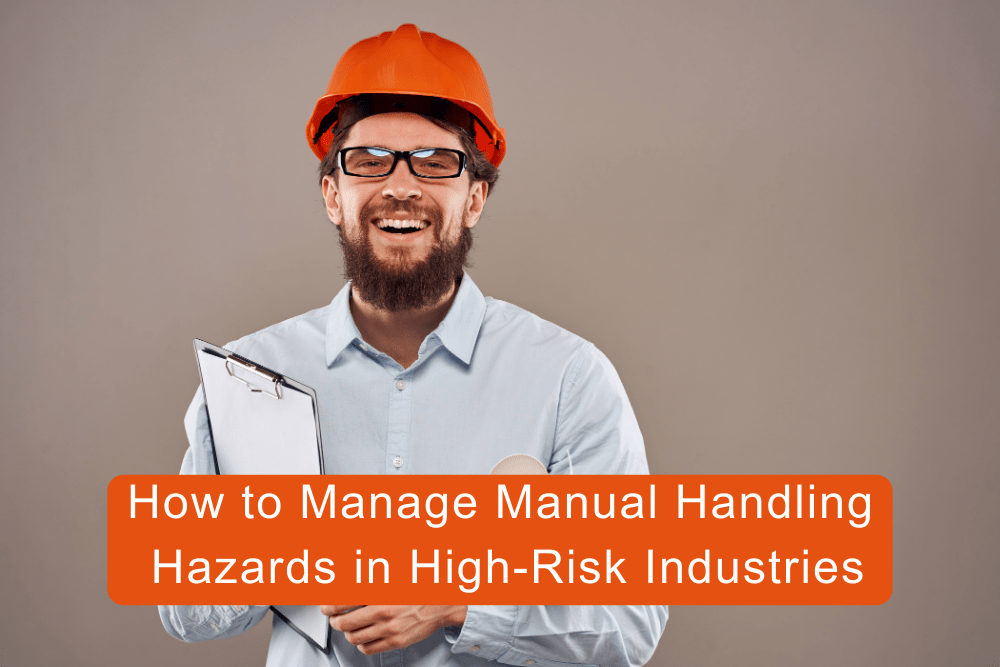In high-risk industries, such as construction, manufacturing, agriculture, and healthcare, manual handling poses a significant threat to the health and safety of workers. Manual handling refers to any activity that involves lifting, carrying, pushing, or pulling objects by hand or bodily force. The very nature of these industries often requires employees to engage in physically demanding tasks, making them more susceptible to injuries related to manual handling.
The primary goal of this blog is to equip employers, safety managers, and workers in high-risk industries with actionable strategies to effectively mitigate manual handling hazards. We aim to go beyond generic advice and provide comprehensive insights that combine ergonomic principles, training techniques, and injury prevention programs to address manual handling risks at their roots.
Understanding Manual Handling Hazards
A. Definition of Manual Handling
Manual handling refers to a wide array of physical activities involving the lifting, lowering, pushing, pulling, carrying, or moving of objects by human effort. It is an integral part of many industries, especially those with high-risk job profiles, where workers regularly engage in these tasks. Whether it’s the construction worker lifting heavy building materials, the healthcare professional transferring patients, or the warehouse operative handling packages, manual handling is ubiquitous in various workplaces.
The physical demands of manual handling tasks can vary significantly, from light and repetitive movements to heavy and occasional lifts. These activities often require precise coordination of muscles and joints, placing considerable stress on the human body. Improper techniques, inadequate training, and disregarding safety measures can escalate the risks associated with manual handling and lead to a higher incidence of injuries and musculoskeletal disorders (MSDs).
B. Common Manual Handling Hazards in High-Risk Industries
In high-risk industries, manual handling hazards abound, presenting unique challenges to worker safety. Some of the most prevalent hazards include:
- Heavy Load Lifting: Workers in construction, manufacturing, and shipping frequently encounter heavy loads that can strain the back, shoulders, and joints, making them susceptible to acute injuries or chronic disorders over time.
- Awkward Postures: Employees often find themselves in awkward positions while handling objects, which can lead to musculoskeletal imbalances and potential long-term injuries.
- Repetitive Movements: Assembly line workers and those involved in repetitive tasks are prone to overuse injuries and fatigue, resulting in reduced productivity and increased likelihood of errors.
- Inadequate Training: Insufficient knowledge of proper lifting techniques and lack of training on ergonomic practices may lead to improper body mechanics, elevating the risk of injuries.
- Inadequate Workspace Design: Poorly designed workstations and inadequate space to maneuver objects can force workers into unsafe postures and increase the chances of accidents.
C. Impact of Manual Handling Injuries on Workers and Businesses
Manual handling injuries can have severe consequences for both workers and businesses. For employees, these injuries can cause excruciating pain, limit mobility, and hamper their ability to perform daily tasks, both at work and home. The physical toll may result in extended sick leaves, reduced job satisfaction, and even long-term disability in extreme cases.
Businesses also bear the brunt of manual handling injuries. Absenteeism and decreased productivity can disrupt workflow and increase operational costs. Furthermore, worker compensation claims and medical expenses add financial burdens to the organization, potentially impacting profitability and competitiveness in the market.
The intangible costs, such as damage to the company’s reputation and morale, cannot be overlooked either. High injury rates can tarnish a company’s image and deter potential talent from seeking employment, making it difficult to attract and retain skilled workers.
D. Relevant Regulations and Standards
Recognizing the importance of addressing manual handling hazards, various regulatory bodies and standards organizations have established guidelines to ensure worker safety. For instance, the Occupational Safety and Health Administration (OSHA) in the United States, the Health and Safety Executive (HSE) in the United Kingdom, and similar agencies worldwide have developed regulations specific to manual handling.
These regulations typically outline employers’ responsibilities in assessing and managing manual handling risks, providing adequate training to employees, and implementing ergonomic practices to prevent injuries. Businesses in high-risk industries must adhere to these standards to maintain compliance and foster a culture of safety in their workplaces.
Identifying High-Risk Industries
A. Overview of High-Risk Industries Prone to Manual Handling Hazards
Several industries are known for their physically demanding tasks and are more susceptible to manual handling hazards. Understanding the nature of these high-risk industries is crucial for devising targeted and effective mitigation strategies. Here’s an overview of some key sectors prone to manual handling hazards:
- Construction: In the construction industry, workers handle heavy building materials, tools, and equipment, often requiring repetitive lifting and bending. The dynamic and unpredictable nature of construction sites adds complexity to manual handling tasks.
- Manufacturing: Manufacturing processes often involve repetitive motions and handling of heavy machinery components, raw materials, and finished products, putting workers at risk of musculoskeletal injuries.
- Healthcare: Healthcare professionals, such as nurses and caregivers, frequently perform patient transfers, which involve lifting and moving individuals with limited mobility, making the healthcare sector prone to manual handling injuries.
- Agriculture: Agricultural workers engage in tasks like lifting heavy produce, carrying equipment, and adopting awkward postures during planting and harvesting, leading to increased risks of injuries.
- Warehousing and Logistics: Workers in warehouses and logistics facilities frequently lift and move heavy packages, leading to a high incidence of manual handling-related incidents.
- Mining: Mining operations often involve handling bulky and heavy materials underground or in remote locations, making manual handling hazards a significant concern.
- Retail: In the retail sector, employees may encounter manual handling risks when stocking shelves, handling inventory, and assisting customers with bulky items.
- Waste Management: Workers in waste management handle heavy bins and containers, exposing them to potential manual handling injuries during collection and disposal activities.
B. Statistics and Data on Manual Handling Incidents in Different Sectors
Statistical data can provide valuable insights into the prevalence and impact of manual handling incidents across various industries. Let’s explore some key statistics and data related to manual handling injuries:
- According to the Bureau of Labor Statistics (BLS), musculoskeletal disorders (MSDs) accounted for approximately 30% of all non-fatal workplace injuries and illnesses in the United States, highlighting the significance of manual handling hazards.
- The Health and Safety Executive (HSE) in the United Kingdom reported that around 8.9 million working days were lost due to work-related MSDs, with a significant proportion attributed to manual handling incidents.
- In the healthcare sector, manual handling incidents account for a substantial number of work-related injuries, with patient handling incidents being a major contributor.
- Studies have shown that warehouse and logistics workers are at a higher risk of manual handling injuries, with lifting and carrying tasks being the leading causes of these incidents.
- The construction industry sees a notable number of manual handling incidents, especially during manual material handling, leading to increased worker absences and compensation claims.
Ergonomics and Manual Handling
A. The Role of Ergonomics in Preventing Manual Handling Injuries
Ergonomics, the science of designing work environments and tasks to fit the capabilities and limitations of the human body, plays a pivotal role in preventing manual handling injuries. By incorporating ergonomic principles into workplace design and practices, businesses can significantly reduce the risk of musculoskeletal disorders (MSDs) and other injuries related to manual handling.
One of the key aspects of ergonomics is understanding the biomechanics of the human body and how it interacts with the work environment. By analyzing tasks involving manual handling, ergonomists can identify potential stress points, awkward postures, and repetitive movements that may lead to injuries over time. Armed with this knowledge, they can then implement appropriate adjustments to minimize the risk.
Ergonomics also involves optimizing the design of tools, equipment, and workstations to facilitate efficient and safe manual handling. For instance, introducing adjustable work surfaces, providing ergonomic handles on tools, and utilizing lifting aids can all contribute to a more ergonomic work environment, reducing the strain on workers’ bodies.
B. Ergonomic Principles for Safe Manual Handling
Implementing ergonomic principles is crucial for ensuring safe manual handling practices. Some key principles include:
- Neutral Body Postures: Encouraging workers to adopt neutral body postures during manual handling tasks can minimize stress on muscles and joints. Keeping the spine in a natural alignment and distributing the load evenly across the body can help prevent injuries.
- Reduce Force and Repetition: Designing tasks in a way that minimizes the force required and reduces repetitive movements can significantly lower the risk of overexertion and cumulative trauma.
- Mechanical Aids: Introducing mechanical aids, such as conveyor belts, forklifts, and lift-assist devices, can decrease the physical demands of manual handling, making tasks safer and more efficient.
- Proper Lifting Techniques: Providing training on proper lifting techniques is essential to ensure workers know how to lift objects safely. Techniques like using the legs to lift, maintaining a straight back, and avoiding twisting motions are vital components of safe manual handling.
- Job Rotation: Implementing job rotation strategies can help reduce prolonged exposure to specific manual handling tasks, allowing different muscle groups to rest and recover during the work shift.
C. Importance of Proper Training and Awareness
No matter how well-designed the workplace and ergonomic solutions may be, their effectiveness relies on the proper training and awareness of the workers. Ensuring that all employees receive comprehensive training on ergonomic practices and safe manual handling techniques is critical for injury prevention.
Training should cover topics such as identifying manual handling hazards, using mechanical aids correctly, and practicing proper body mechanics. Hands-on demonstrations and simulations can enhance the learning experience and help workers internalize safe handling habits.
Moreover, fostering a culture of awareness is equally important. Encouraging open communication about any discomfort or signs of strain during manual handling tasks can prompt early intervention and prevent injuries from worsening. By promoting a culture that prioritizes safety and encourages reporting, employers can create an environment where workers feel valued and supported.
Regular refresher training and continuous reinforcement of safe manual handling practices can also reinforce good habits and keep safety at the forefront of employees’ minds.
Get proper training vetted by Experts in Manual Handling here
V. Best Practices for Mitigating Manual Handling Hazards
A. Workplace Assessment: Identifying Potential Hazards
Conducting a comprehensive workplace assessment is the first step in mitigating manual handling hazards. This assessment involves identifying tasks that involve manual handling, evaluating workstations, and analyzing the work environment for potential risks. Here are some key aspects of workplace assessment:
- Task Analysis: Understanding the specific manual handling tasks performed by workers, the frequency of these tasks, and the loads involved can help pinpoint high-risk activities.
- Observation and Data Collection: Observing workers in action and collecting data on their movements and postures can provide valuable insights into potential hazards and areas for improvement.
- Worker Input: Involving workers in the assessment process empowers them to share their experiences and concerns, ensuring a more comprehensive analysis of manual handling hazards.
- Ergonomic Evaluation: Engaging ergonomics experts to evaluate workstations, tools, and equipment can help identify potential design flaws that contribute to manual handling risks.
B. Engineering Controls to Reduce Risks
Engineering controls involve modifying the work environment and tasks to reduce the physical demands of manual handling. Implementing these controls can effectively mitigate hazards and prevent injuries. Some key engineering control measures include:
- Automation: Introducing automation in manual handling tasks, such as using conveyor belts or robotic assistance, can minimize the need for manual lifting and carrying.
- Adjustable Workstations: Providing adjustable work surfaces and equipment allows workers to customize their workstations to suit their individual needs and reduce awkward postures.
- Reorganizing Workflows: Rearranging workflows and task sequences can help minimize the distance and effort required for manual handling activities.
- Reducing Weight: Redesigning products and packaging to decrease weight can significantly lower the physical demands on workers during handling and transportation.
C. Safe Lifting Techniques and Body Mechanics
Promoting safe lifting techniques and proper body mechanics is crucial for minimizing the risk of manual handling injuries. Training employees on the following techniques can foster a safety-conscious mindset:
- Bend the Knees: Instruct workers to bend their knees when lifting objects and avoid bending at the waist, distributing the load evenly between the legs.
- Maintain Neutral Spine: Encourage workers to keep their back straight and maintain a neutral spine position throughout the lifting process.
- Keep the Load Close: Advise employees to keep the load as close to their body as possible during lifting to reduce the strain on their back and arms.
- Avoid Twisting: Emphasize the importance of avoiding twisting or rotating the body while carrying a load, as this can lead to strain and injury.
D. Utilizing Mechanical Aids and Assistive Devices
Incorporating mechanical aids and assistive devices is a proactive approach to mitigate manual handling hazards and improve overall efficiency. Some commonly used mechanical aids include:
- Lift-Assist Devices: Implementing lift-assist devices, such as hoists and lift tables, can greatly reduce the physical effort required for lifting heavy loads.
- Hand Trucks and Dollies: Providing hand trucks and dollies for transporting heavy items can minimize the strain on workers during material handling tasks.
- Pallet Jacks and Forklifts: Utilizing pallet jacks and forklifts for moving heavy materials in warehouses and manufacturing facilities can enhance safety and productivity.
E. Teamwork and Communication in Manual Handling Tasks
Fostering teamwork and effective communication among workers is vital for ensuring safe manual handling practices. Encourage the following practices:
- Team Lifts: Encourage team lifts for heavier or bulky items that may require multiple workers to handle safely.
- Communication Signals: Establish clear and standardized communication signals between workers during manual handling tasks to ensure coordination and avoid accidents.
- Reporting Hazards: Encourage workers to report potential hazards or difficulties encountered during manual handling, promoting a culture of proactive risk management.
Employee Training and Education
A. Importance of Comprehensive Training Programs
Comprehensive training programs are a cornerstone in the effort to mitigate manual handling hazards and promote a safe working environment. Investing in employee training and education demonstrates a commitment to the well-being of the workforce and reinforces the organization’s dedication to workplace safety.
The importance of comprehensive training lies in its ability to equip employees with the knowledge and skills needed to identify, prevent, and manage manual handling risks effectively. By instilling a deep understanding of ergonomic principles, safe lifting techniques, and proper body mechanics, workers become better equipped to perform their duties with reduced risk of injury.
Moreover, comprehensive training programs raise awareness about the potential consequences of manual handling injuries, helping employees recognize the significance of adhering to safe practices. As workers become more informed about the impact of manual handling hazards on their health and work-life balance, they are more likely to take safety precautions seriously.
B. Effective Training Techniques for Safe Manual Handling
To ensure the effectiveness of training programs, organizations should employ a variety of training techniques that cater to different learning styles and preferences. Here are some effective training techniques for safe manual handling:
- Hands-on Demonstrations: Conducting hands-on demonstrations allows workers to observe and practice safe lifting techniques in a controlled environment. This approach fosters experiential learning and enhances retention of the learned skills.
- Video Modules: Utilizing video modules that showcase real-life scenarios and proper manual handling practices can engage employees and make the training content more relatable.
- Interactive Workshops: Organizing interactive workshops and group discussions enables workers to share their experiences, ask questions, and collaborate on finding solutions to manual handling challenges.
- Online Training Platforms: Leveraging online training platforms provides flexibility for employees to complete training modules at their own pace, making it convenient for those with varying work schedules.
- Skill Assessment: Conducting skill assessments and post-training evaluations helps identify areas where employees may need additional support and reinforcement.
C. Encouraging Employee Engagement and Participation
Encouraging employee engagement and participation is crucial for the success of manual handling training programs. Here’s how organizations can foster active involvement:
- Incentives and Recognition: Offering incentives, such as recognition awards or small rewards, for exemplary adherence to safe manual handling practices can motivate employees to actively participate in training.
- Employee Involvement in Program Design: Involving employees in the design and development of training programs empowers them to have a voice in shaping the content to meet their specific needs.
- Continuous Training Updates: Regularly updating training materials and incorporating new findings and best practices keeps the content fresh and relevant, encouraging employees to stay engaged.
- Safety Champions: Designating safety champions within teams or departments can create positive peer pressure and promote a safety-conscious culture.
- Interactive Training Materials: Utilizing interactive training materials, such as quizzes and simulations, keeps employees engaged and helps reinforce the key concepts.
By fostering a culture that values ongoing learning and prioritizes safety, organizations can ensure that manual handling training becomes an integral part of the company’s ethos.
For Employee Training and Skill Development, you may check our Courses here.
Injury Prevention and Early Intervention
A. Implementing Injury Prevention Programs
Implementing injury prevention programs is a proactive approach that demonstrates an organization’s commitment to the health and safety of its workforce. These programs are designed to identify and address potential hazards before they escalate into injuries, helping to create a safer work environment for employees. Here are key components of effective injury prevention programs:
- Risk Assessment: Conducting regular risk assessments allows organizations to identify manual handling hazards and prioritize areas for intervention based on their severity and likelihood of occurrence.
- Engineering Controls: As part of injury prevention programs, engineering controls are employed to modify workstations and processes to minimize manual handling risks. These controls can include the introduction of mechanical aids, workstation redesign, and automation of tasks.
- Training and Education: Continued training and education are integrated into injury prevention programs to keep employees informed about the latest safety protocols and to reinforce best practices in manual handling.
- Regular Inspections: Regularly inspecting work areas and equipment ensures that engineering controls are functioning correctly and identifies any emerging hazards that may require attention.
- Feedback and Communication: Encouraging employees to provide feedback on potential hazards and suggestions for improvement fosters a culture of open communication and active participation in injury prevention.
B. Creating a Culture of Reporting and Incident Documentation
Creating a culture of reporting and incident documentation is vital to fostering a transparent and proactive approach to injury prevention. By encouraging employees to report near-miss incidents, minor injuries, and hazards, organizations gain valuable insights into areas that may require further attention. Here’s how to promote a culture of reporting and incident documentation:
- Non-Punitive Approach: Ensuring that reporting is non-punitive and confidential encourages employees to come forward without fear of reprisals.
- Incident Reporting Systems: Implementing user-friendly incident reporting systems, whether digital or paper-based, streamlines the reporting process and facilitates data collection for analysis.
- Management Support: Demonstrating management support for incident reporting reinforces the importance of identifying potential risks and seeking continuous improvement.
- Root Cause Analysis: Conducting thorough investigations and root cause analyses of incidents helps uncover underlying issues and informs preventive measures.
- Sharing Lessons Learned: Sharing lessons learned from incident investigations across the organization promotes a collective learning experience and encourages a proactive approach to safety.
C. Early Intervention Strategies for Manual Handling Injuries
Early intervention is essential for managing manual handling injuries promptly and effectively. By addressing injuries at their early stages, organizations can prevent them from worsening and minimize their impact on employee well-being and productivity. Here are effective early intervention strategies for manual handling injuries:
- Prompt Reporting: Encouraging employees to report any discomfort or signs of injury immediately enables swift intervention and appropriate medical attention.
- Access to Healthcare Professionals: Providing access to healthcare professionals, such as occupational therapists or physical therapists, allows injured employees to receive timely assessments and personalized treatment plans.
- Modified Duties: Temporarily modifying employees’ duties to reduce manual handling demands while they recover can help prevent exacerbation of injuries.
- Rehabilitation Programs: Implementing rehabilitation programs, including targeted exercises and therapies, helps injured workers regain strength and mobility, expediting their return to full duties.
- Workplace Accommodations: Implementing workplace accommodations, such as adjustable workstations or assistive devices, can support injured employees in their return to work process.
By prioritizing injury prevention and early intervention, organizations can create a safer and more supportive work environment. These proactive measures not only protect employees from harm but also contribute to improved productivity, reduced absenteeism, and a positive company culture centered around employee well-being.
Monitoring, Evaluation, and Continuous Improvement
A. Establishing Metrics to Monitor Manual Handling Hazards
To effectively manage manual handling hazards, it is essential to establish relevant metrics for monitoring and measuring the success of mitigation efforts. These metrics provide valuable data to assess the effectiveness of existing strategies and identify areas that require further improvement. Here are some key metrics to consider:
- Injury Rates: Tracking the frequency and severity of manual handling injuries over time provides insights into the overall safety performance and highlights areas of concern.
- Near-Miss Reporting: Monitoring near-miss incidents helps identify potential hazards before they result in injuries, allowing for proactive measures to prevent future incidents.
- Compliance with Safety Protocols: Evaluating the level of compliance with established safety protocols and procedures indicates how well workers adhere to safe manual handling practices.
- Employee Feedback: Gathering feedback from employees through surveys or focus groups can offer valuable insights into the perceived effectiveness of current safety measures and potential areas for improvement.
- Productivity Indicators: Assessing changes in productivity levels in relation to the implementation of manual handling mitigation strategies can help understand their impact on overall operations.
B. Periodic Evaluation of Mitigation Strategies
Periodic evaluation of mitigation strategies is crucial to ensure that manual handling hazards remain effectively managed and that adjustments can be made as needed. Regular evaluations provide an opportunity to assess the outcomes of implemented measures and adapt to changes in the work environment. Here’s how to conduct periodic evaluations:
- Scheduled Reviews: Establishing a regular schedule for reviewing the effectiveness of mitigation strategies ensures that evaluations occur consistently.
- Data Analysis: Analyzing the data collected from established metrics helps identify trends, patterns, and areas requiring improvement.
- Employee Input: Involving employees in the evaluation process through surveys or discussions allows for a comprehensive assessment of the strategies’ impact on their daily work.
- Expert Consultation: Seeking input from ergonomics experts and safety professionals can provide valuable insights and recommendations for refining existing strategies.
- Comparison to Benchmarks: Comparing the organization’s safety performance to industry benchmarks helps gauge its standing in relation to best practices.
C. Learning from Incidents: Continuous Improvement Approach
A continuous improvement approach is integral to effectively managing manual handling hazards. Learning from incidents, both near-misses and actual injuries, is crucial for identifying potential gaps in the mitigation strategies and making data-driven improvements. Here’s how to foster a continuous improvement approach:
- Incident Investigations: Conducting thorough investigations of incidents helps uncover root causes and underlying issues, informing the development of targeted improvements.
- Lessons Learned: Sharing the lessons learned from incident investigations throughout the organization ensures that all stakeholders benefit from the insights gained.
- Corrective Actions: Implementing corrective actions based on incident findings demonstrates a commitment to preventing similar incidents in the future.
- Feedback Loops: Establishing feedback loops between employees and safety management allows for ongoing communication and suggestions for improvement.
- Innovation and Technology: Embracing innovation and technology can lead to the development of new solutions and tools to enhance manual handling safety.
By adopting a continuous improvement approach, organizations foster a culture of learning and adaptability, ensuring that safety measures remain effective in the face of evolving challenges.

Conclusion
Mitigating manual handling hazards is of utmost importance in high-risk industries to ensure the health, safety, and well-being of workers. The physical demands of manual handling tasks can lead to a variety of injuries and musculoskeletal disorders (MSDs), impacting both employees and businesses.
In conclusion, mitigating manual handling hazards is not only a legal and ethical responsibility for businesses but also a strategic investment in the health and longevity of their workforce. By placing a strong emphasis on safety, adhering to best practices, and fostering a safety-first culture, organizations in high-risk industries can create workplaces that prioritize employee welfare and thrive in a dynamic and competitive landscape. Let us all commit to the goal of safer workplaces and healthier workers, forging a path towards a brighter future for high-risk industries and their invaluable human resources.
- The Ultimate Guide to Manual Handling 2023
- What are the Risks Associated with Manual Handling
- Compliance with Manual Handling Laws: What You Need to Know
- Empower Your Team: Advanced Training for Manual Handling Safety
- How to Prevent Musculoskeletal Injuries in Manual Handling Tasks
- Proven Strategies for Safe Manual Handling: Effective Techniques
Frequently Asked Questions (FAQs)
What is high-risk manual handling?
High-risk manual handling refers to tasks involving lifting, carrying, or moving heavy loads, potentially leading to musculoskeletal injuries. These tasks pose a significant risk to workers’ health and safety.
What is the hazard and risk of manual handling?
The hazard in manual handling is the physical demand of lifting or moving objects. The risk involves the likelihood of injury or musculoskeletal disorders resulting from these tasks.
What are the 5 risk controls for manual handling tasks?
The five risk controls for manual handling tasks include using mechanical aids, providing training on safe lifting techniques, implementing ergonomic workstations, conducting risk assessments, and encouraging teamwork in handling heavy loads.
What are the major risk factor categories in manual handling?
The major risk factor categories in manual handling include heavy loads, awkward postures, repetitive movements, lack of training, and inadequate work environment design. Addressing these factors is crucial for minimizing manual handling hazards.













